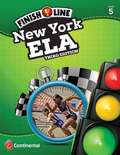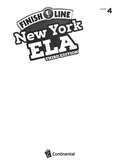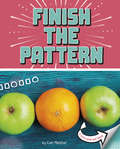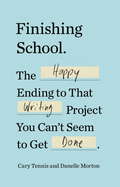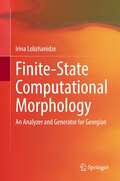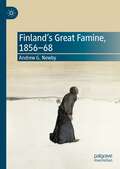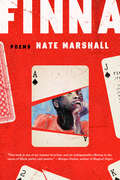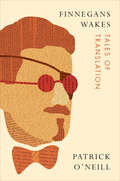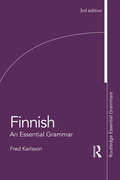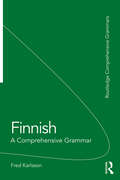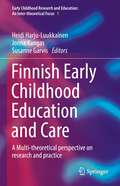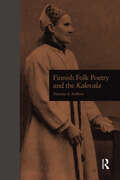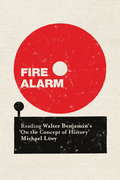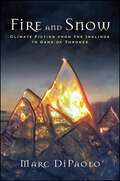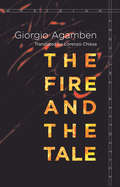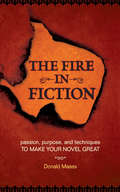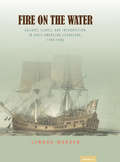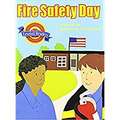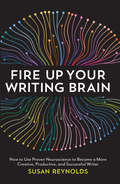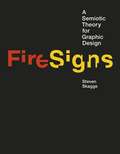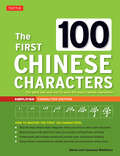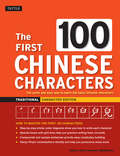- Table View
- List View
Finish Line New York ELA: Grade 5 (Third Edition)
by Continental Press StaffNeed more standards support in your lesson plans? Finish Line New York ELA is the perfect fit with step-by-step instruction to help students take on the challenging nature of New York's Common Core Learning Standards (CCLS). This next generation of Finish Line includes 300+ pages of focused practice and a new lesson format. The gradual release model is extended to four parts to promote deeper learning: Skill Introduction, Focused Instruction, Guided Practice, and Independent Practice. Guided questions model the thought process. Language Arts/Writing is integrated into the book. A full unit of writing standards helps students practice the writing process, learn how to answer open-ended questions, and apply grammar and usage conventions. Much like New York's standards and assessments, students are required to do close reading of rigorous text. Reviews include PARCC-type items, as well as multiple-choice, open-ended, and multipart questions. Finish Line is designed to supplement core basal programs, including ReadyGEN(tm) and Common Core Code X(tm).
Finish Line New York ELA: Grade 4
by Continental Press StaffFinish Line New York ELA Third Edition Grade 4
Finish the Pattern: A Turn-and-See Book (What's Next?)
by Cari MeisterFrom the days of the week to playing hopscotch, patterns are all around you. Keep turning the pages to find out how your life is full of patterns and sequences.
Finishing School: The Happy Ending to That Writing Project You Can't Seem to Get Done
by Cary Tennis Danelle MortonAll too many people start a writing project with grand ambitions but reach a crisis of completion. Finishing School helps writers reignite the passion that started them on the project in the first place and work steadily to get it done. Untold millions of writing projects—begun with hope and a little bit of hubris—lie abandoned in desk drawers, in dated files on computer desktops, and in the far reaches of the mind. Too often, writers get tangled in self-abuse—their self-doubt, shame, yearning for perfection, and even arrogance get in the way. In Finishing School, Cary Tennis and Danelle Morton help writers overcome these emotional blocks and break down daunting projects into manageable pieces. Tennis first convened a Finishing School so that writers could help one another stay on track and complete their work. Since they weren’t actually critiquing one another’s writing, there was no jockeying for the title of best writer or the usual writing group politics; there was only a shared commitment to progress. Without guilt, blame, and outside critique, students were more productive than they imagined possible. Through this program, they were able to complete novels that they’d been struggling with for almost two decades, finish screenplays drafts, and revive interest in long-neglected PhD theses. In this book, the authors share this proven and easily replicable technique, as well as their own writing success stories.From the Trade Paperback edition.
Finite-State Computational Morphology: An Analyzer and Generator for Georgian
by Irina LobzhanidzeThis handbook provides a comprehensive account of current research on the finite-state morphology of Georgian and enables the reader to enter quickly into Georgian morphosyntax and its computational processing. It combines linguistic analysis with application of finite-state technology to processing of the language. The book opens with the author’s synoptic overview of the main lines of research, covers the properties of the word and its components, then moves up to the description of Georgian morphosyntax and the morphological analyzer and generator of Georgian.The book comprises three chapters and accompanying appendices. The aim of the first chapter is to describe the morphosyntactic structure of Georgian, focusing on differences between Old and Modern Georgian. The second chapter focuses on the application of finite-state technology to the processing of Georgian and on the compilation of a tokenizer, a morphological analyzer and a generator for Georgian. The third chapter discusses the testing and evaluation of the analyzer’s output and the compilation of the Georgian Language Corpus (GLC), which is now accessible online and freely available to the research community.Since the development of the analyzer, the field of computational linguistics has advanced in several ways, but the majority of new approaches to language processing has not been tested on Georgian. So, the organization of the book makes it easier to handle new developments from both a theoretical and practical viewpoint.The book includes a detailed index and references as well as the full list of morphosyntactic tags. It will be of interest and practical use to a wide range of linguists and advanced students interested in Georgian morphosyntax generally as well as to researchers working in the field of computational linguistics and focusing on how languages with complicated morphosyntax can be handled through finite-state approaches.
Finland’s Great Famine, 1856-68
by Andrew G. NewbyThis book will provide a thematic overview of one of European history’s most devastating famines, the Great Finnish Famine of the 1860s. In 1868, the nadir of several years of worsening economic conditions, 137,000 people (approximately 8% of the Finnish population) perished as the result of hunger and disease. The attitudes and policies enacted by Finland’s devolved administration tended to follow European norms, and therefore were often similar to the “colonial” practices seen in other famines at the time. What is distinctive about this catastrophe in a mid-nineteenth-century context, is that despite Finland being a part of the Russian Empire, it was largely responsible for its own governance, and indeed was developing its economic, political and cultural autonomy at the time of the famine. Finland’s Great Famine 1856-68 examines key themes such as the use of emergency foods, domestic and overseas charity, vagrancy and crime, emergency relief works, and emigration.
Finna: Poems
by Nate MarshallSharp, lyrical poems celebrating the Black vernacular—its influence on pop culture, its necessity for familial survival, its rite in storytelling and in creating the safety found only within its intimacyDefinition of finna, created by the author: fin·na /ˈfinə/ contraction: (1) going to; intending to [rooted in African American Vernacular English] (2) eye dialect spelling of &“fixing to&” (3) Black possibility; Black futurity; Blackness as tomorrowThese poems consider the brevity and disposability of Black lives and other oppressed people in our current era of emboldened white supremacy, and the use of the Black vernacular in America&’s vast reserve of racial and gendered epithets. Finna explores the erasure of peoples in the American narrative; asks how gendered language can provoke violence; and finally, how the Black vernacular, expands our notions of possibility, giving us a new language of hope:nothing about our people is romantic& it shouldn&’t be. our people deservepoetry without meter. we deserve ourown jagged rhythm & our own unevenwalk towards sun. you make happening happen.we happen to love. this is our greatestaction.
Finnegans Wakes: Tales of Translation
by Patrick O'NeillJames Joyce's astonishing final text, Finnegans Wake (1939), is universally acknowledged to be entirely untranslatable. And yet, no fewer than fifteen complete renderings of the 628-page text exist to date, in twelve different languages altogether – and at least ten further complete renderings have been announced as underway for publication in the early 2020s, in nine different languages. Finnegans Wakes delineates, for the first time in any language, the international history of these renderings and discusses the multiple issues faced by translators. The book also comments on partial and fragmentary renderings from some thirty languages altogether, including such perhaps unexpected languages as Galician, Guarani, Chinese, Korean, Turkish, and Irish, not to mention Latin and Ancient Egyptian. Excerpts from individual renderings are analysed in detail, together with brief biographical notes on numerous individual translators. Chronicling renderings spanning multiple decades, Finnegans Wakes illustrates the capacity of Joyce's final text to generate an inexhaustible multiplicity of possible meanings among the ever-increasing number of its impossible translations.
Finnish: A Comprehensive Grammar (Routledge Essential Grammars)
by Fred KarlssonThis thoroughly revised third edition of Finnish: An Essential Grammar is grounded in fundamental insights of modern linguistics and incorporates some of the latest achievements in the description of written and spoken Finnish. It gives a systematic account of the structures of the written language and offers increased attention to the key characteristics of present-day colloquial Finnish. No prior knowledge is assumed on the part of the reader and grammatical rules are clearly explained without jargon. Features of this new edition include: • pronunciation guide, including the tendencies in present-day colloquial Finnish • thorough descriptions of morphology (word structure) and syntax (sentence structure) • clear rules and an abundance of concrete examples, from both written and colloquial Finnish • updated vocabulary in the examples • an effective new scheme for detecting the morphological structure of any word form • subject index. This is the ideal reference source both for those studying Finnish independently and for students in schools, colleges, universities and adult classes of all types.
Finnish: A Comprehensive Grammar (Routledge Grammars)
by Fred KarlssonFinnish: A Comprehensive Grammar presents a fresh, accessible and thorough description of the language, concentrating on the real patterns of use in modern Finnish. The book moves from the sound system through morphology and word classes to a detailed analysis of sentence structures and semantic features. Key features include: particular focus on examples from spoken Finnish reflecting current usage, grammatic phenomena classified as common or rare, appendices distinguishing base forms from final letter combinations, English-Finnish contrasts highlighted throughout. This Comprehensive Grammar is an essential reference for the intermediatre and advanced learner and user of Finnish.
Finnish Early Childhood Education and Care: A Multi-theoretical perspective on research and practice (Early Childhood Research and Education: An Inter-theoretical Focus #1)
by Susanne Garvis Heidi Harju-Luukkainen Jonna KangasThis book highlights contemporary questions around Early Childhood Education in Finland. It explores a range of issues relating to policies and practices in Early Childhood Education and Care (ECEC). The book features many aspects of the so-called Nordic model that is evident in different practices and policies of the Finnish ECEC system. Among others topics, it discusses playful learning, storycrafting, scientific literacy, pedagogical leadership, family-related variables, and Sami language learning. The findings provide important insights into the Finnish ECEC model and illustrate relevant issues facing Finland. All of the 14 chapters present unique research and give the reader the opportunity to understand how the ECEC services during children’s early years are defined and implemented. Each chapter includes a discussion of the educational outcome and highlights critical perspectives. In Finland ECEC is seen as an investment in the future. The Finnish ECEC system is one of the most equal in the world. The high-quality education is available to both private and public sectors. National curriculum and laws for early education have gone through a significant reform during the last decade, with the quality, practices and teachers’ competences being defined in order to support children’s future learning skills. ECEC in Finland is a unique combination of international influences and local intentions to put each child and family at the centre of the services. The systematic and goal-oriented ECEC system consists of upbringing, education and care with an emphasis on pedagogy in order to produce excellence for the future. Its overall planning, guidance and monitoring system is one of a kind.
Finnish Folk Poetry and the Kalevala (New Perspectives in Folklore #1)
by Thomas A. DuBoisSince its initial publication in the early nineteenth century, Elias Lonnrot’s Finnish epic Kalevala has attracted international interest and scholarship. However, the author comments that the distorting lenses of translation, cultural difference and historical distance, have rendered the work a cryptic and often misinterpreted text outside of its country of origin. Even within Finland, scholars have found it difficult at times to judge the relation of the Kalevala to its oral sources. Lonnrot’s meticulous notes and discussions of intent and accomplishment make clear what he changed and how he went about it, but give us less inkling of why. This study's view is that the key to understanding Lonnrot’s changes lies in Romantic aesthetics and in the intellectual and socio-political agendas which they encode. Lonnrot created a Romantic epic out of Baltic-Finnic folk poetry, an epic complete with the narrative, generic, gendered and political characteristics of literary epics in nineteenth century’ Europe.
Fins, Wings, and Legs
by Margaret Clyne Rachel GriffithsComplete Classroom Library includes one each of the following: Math LibraryScience LibrarySocial Studies LibraryContent Area Classroom Libraries include: 1 display box containing 10 6-packs (60 little books)1 Teacher Resource Portfolio1 Assessment Book (where available)Big Book Collection includes: 10 Big Books for Science10 Big Books for Social Studies10 Big Books for MathClassroom Library Add-on Packs include 1 copy of each title from the social studies, science, and math libraries. Add-On Packs include 1 copy of each title.
Fire Alarm: Reading Walter Benjamin's 'On the Concept of History'
by Michael Lowy Chris TurnerThis illuminating study of Benjamin's final essay helps unlock the mystery of this great philosopherRevolutionary critic of the philosophy of progress, nostalgic of the past yet dreaming of the future, romantic partisan of materialism -- Walter Benjamin is in every sense of the word an "unclassifiable" philosopher. His essay "On the Concept of History" was written in a state of urgency, as he attempted to escape the Gestapo in 1940, before finally committing suicide.In this scrupulous, clear and fascinating examination of this essay, Michael Löwy argues that it remains one of the most important philosophical and political writings of the twentieth century. Looking in detail at Benjamin's celebrated but often mysterious text, and restoring the philosophical, theological and political context, Löwy highlights the complex relationship between redemption and revolution in Benjamin's philosophy of history.From the Trade Paperback edition.
Fire and Snow: Climate Fiction from the Inklings to Game of Thrones (SUNY Press Open Access)
by Marc DiPaoloFellow Inklings J. R. R. Tolkien and C. S. Lewis may have belonged to different branches of Christianity, but they both made use of a faith-based environmentalist ethic to counter the mid-twentieth-century's triple threats of fascism, utilitarianism, and industrial capitalism. In Fire and Snow, Marc DiPaolo explores how the apocalyptic fantasy tropes and Christian environmental ethics of the Middle-earth and Narnia sagas have been adapted by a variety of recent writers and filmmakers of "climate fiction," a growing literary and cinematic genre that grapples with the real-world concerns of climate change, endless wars, and fascism, as well as the role religion plays in easing or escalating these apocalyptic-level crises. Among the many other well-known climate fiction narratives examined in these pages are Game of Thrones, The Hunger Games, The Handmaid's Tale, Mad Max, and Doctor Who. Although the authors of these works stake out ideological territory that differs from Tolkien's and Lewis's, DiPaolo argues that they nevertheless mirror their predecessors' ecological concerns. The Christians, Jews, atheists, and agnostics who penned these works agree that we all need to put aside our cultural differences and transcend our personal, socioeconomic circumstances to work together to save the environment. Taken together, these works of climate fiction model various ways in which a deep ecological solidarity might be achieved across a broad ideological and cultural spectrum.This book is freely available in an open access edition thanks to Knowledge Unlatched—an initiative that provides libraries and institutions with a centralized platform to support OA collections and from leading publishing houses and OA initiatives. Learn more at the Knowledge Unlatched website at: https://www.knowledgeunlatched.org/, and access the book online at the SUNY Open Access Repository at <a href="http://hdl.handle.net/20.500.12648/7137 ">http://hdl.handle.net/20.500.12648/7137 .
The Fire and the Tale
by Giorgio Agamben Lorenzo ChiesaWhat is at stake in literature? Can we identify the fire that our stories have lost, but that they strive, at all costs, to rediscover? And what is the philosopher's stone that writers, with the passion of alchemists, struggle to forge in their word furnaces? For Giorgio Agamben, who suggests that the parable is the secret model of all narrative, every act of creation tenaciously resists creation, thereby giving each work its strength and grace. The ten essays brought together here cover works by figures ranging from Aristotle to Paul Klee and illustrate what urgently drives Agamben's current research. As is often the case with his writings, their especial focus is the mystery of literature, of reading and writing, and of language as a laboratory for conceiving an ethico-political perspective that places us beyond sovereign power.
The Fire in Fiction: Passion, Purpose and Techniques to Make Your Novel Great
by Donald MaassMaass, a literary agent and author of other books on novel writing, explains how novelists can instill their stories with passion and keep the reader excited and engaged. He contends that passion is a practical tool that can be drawn on at any time and shows how the day-to-day story development of a novel is key. He provides examples of strong characters, settings, voice, and conflict in published novels, and how to make the impossible feel real and write hyperreality, with exercises for working on writing techniques. There is no bibliography. Annotation ©2009 Book News, Inc. , Portland, OR (booknews. com)
Fire on the Water: Sailors, Slaves, and Insurrection in Early American Literature, 1789-1886 (Transits: Literature, Thought & Culture 1650-1850)
by Lenora WarrenLenora Warren tells a new story about the troubled history of abolition and slave violence by examining representations of shipboard mutiny and insurrection in late eighteenth- and early nineteenth-century Anglo-American and American literature. Fire on the Water centers on five black sailors, whose experiences of slavery and insurrection either inspired or found resonance within fiction: Olaudah Equiano, Denmark Vesey, Joseph Cinqué, Madison Washington, and Washington Goode. These stories of sailors, both real and fictional, reveal how the history of mutiny and insurrection is both shaped by, and resistant to, the prevailing abolitionist rhetoric surrounding the efficacy of armed rebellion as a response to slavery. Pairing well-known texts with lesser-known figures (Billy Budd and Washington Goode) and well-known figures with lesser-known texts (Denmark Vesey and the work of John Howison), this book reveals the richness of literary engagement with the politics of slave violence. Published by Bucknell University Press. Distributed worldwide by Rutgers University Press.
Fire Up Your Writing Brain: How to Use Proven Neuroscience to Become a More Creative, Productive, and Succes sful Writer
by Susan ReynoldsIgnite Your Writing Brain!Whether you're an experienced writer or just starting out, an endless number of pitfalls can trip up your efforts, from procrastination and writer's block to thin characters and uninspired plots. Luckily, you have access to an extraordinary writing tool that can help overcome all of these problems: your brain.Fire Up Your Writing Brain teaches you how to develop your brain to its fullest potential. Based on proven, easy-to-understand neuroscience, this book details ways to stimulate, nurture, and hone your brain into the ultimate writing tool. Inside, you'll learn how to:Identify the type of writer you are: Do you think or feel your way through writing a book? Are you a pantser or a plotter?Develop writing models that accelerate your learning curve.Hardwire your brain for endurance and increased productivity.Brainstorm better character concepts and plot points.Learn to edit your manuscript on both a macro and micro level.Recharge a lagging brain to gain an extra burst of creativity.Filled with accessible instruction, practical techniques, and thought-provoking exercises, Fire Up Your Writing Brain shows you how to become a more productive, creative, and successful writer--a veritable writing genius!"An excellent resource--the way that neuroscience and the art of writing are jointly explored allows for a new, unique, and practical integration of the two." --Teresa Aubele-Futch, Ph.D., Assistant Professor of Neuroscience at Saint Mary's College, Notre Dame and co-author of Train Your Brain to Get Happy and Train Your Brain to Get Rich"Full of neuroscience facts and tips, this inspiring book will change your brain--and your writing life. I learned techniques that I'll apply to my students and my own writing." --Linda Joy Myers, President of the National Association of Memoir Writers and award-winning author of Don't Call Me Mother: A Daughter's Journey from Abandonment to Forgiveness
Firebrand Waves of Digital Activism 1994-2014: The Rise and Spread of Hacktivism and Cyberconflict
by Athina KaratzogianniThis book introduces four waves of upsurge in digital activism and cyberconflict. The rise of digital activism started in 1994, was transformed by the events of 9/11, culminated in 2011 with the Arab Spring uprisings, and entered a transformative phase of control and mainstreaming since 2013 with the Snowden affair.
FireSigns: A Semiotic Theory for Graphic Design
by Steven SkaggsGraphic design has been an academic discipline since the post-World War II era, but it has yet to develop a coherent theoretical foundation. Instead, it proceeds through styles, genres, and imitation, drawing on sources that range from the Bauhaus to deconstructionism. In FireSigns, Steven Skaggs offers the foundation for a semiotic theory of graphic design, exploring semiotic concepts from design and studio art perspectives and offering useful conceptual tools for practicing designers.Semiotics is the study of signs and significations; graphic design creates visual signs meant to create a certain effect in the mind (a "FireSign"). Skaggs provides a network of explicit concepts and terminology for a practice that has made implicit use of semiotics without knowing it. He offers an overview of the metaphysics of visual perception and the notion of visual entities, and, drawing on the pragmatic semiotics of the philosopher Charles Sanders Peirce, looks at visual experience as a product of the action of signs. He introduces three conceptual tools for analyzing works of graphic design -- semantic profiles, the functional matrix, and the visual gamut -- that allow visual "personality types" to emerge and enable a greater understanding of the range of possibilities for visual elements. Finally, he applies these tools to specific analyses of typography.
The First 100 Chinese Characters: Simplified Character Edition
by Alison Matthews Laurence MatthewsThis book is a quick and easy way to learn basic Chinese Characters.All beginning students of Chinese struggle to memorize and learn to write the Chinese characters. The First 100 Chinese Characters adopts a structural approach which helps students to quickly master the basic characters that are fundamental to this language.The English meanings, pronunciations in hanyu pinyin and alternate forms (if any) for each Chinese character are presented along with a stroke order guide and spaces for writing practice. Printed with gray guidelines, the stroke order guides are designed to be traced over to teach students the standard sequence of strokes used to write the character. Related compounds and phrases are given to assist in vocabulary building. Three indexes at the back allow the characters to be looked-up by their English meanings, hanyu pinyin pronunciations, or radicals. Extra practice sheets are also provided.This book contains: Step-by-step stroke order diagrams show you how to write each character. Special boxes with grid lines help you practice writing them correctly. Compounds and sample sentences provide easy vocabulary building. Hanyu pinyin romanizations identify and help you pronounce every word.
The First 100 Chinese Characters: Traditional Character Edition
by Laurence Matthews Alison MatthewsThis book is a quick and easy way to learn the first 100 basic Chinese traditional characters.For effective leaning, memorization and practice, each Chinese character is shown separately on a single page, together with its English definitions, hanyu pinyin romanization, alternate form (if any), a stroke order guide and ample space for writing practice. Printed in gray lines, the stroke order guides introduce the student to the standard stroke sequence used in writing the characters, by tracing over them. After learning the correct stroke order, the student can then practice writing the character on their own, thus reinforcing recognition and memorization. Large boxes with grids for correct proportions are provided. Related compounds and phrases containing each character are also included to assist in vocabulary building. Three indexes (alphabetically by the English meanings and the pinyin romanization, and by radicals) are provided at the back of the book for quick and esy reference, along with extra sheets of blank boxes for writing practice. Featured are:The 100 most frequently-used Chinese charactersFoundation characters for the HSK A level language proficiency testStandard hanyu pinyin romanizationsStep-by-step stroke order guides and ample space for writing practiceOver 500 words and phrases containing the basic charactersConcise English definitions
